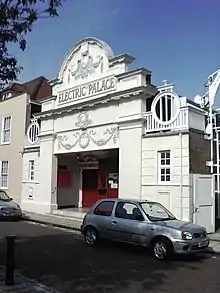Harold Ridley Hooper
Harold Ridley Hooper (1886, Bury St Edmunds – 1953)[1][2] was an English architect based in Ipswich, Suffolk.

Electric Palace Cinema, Harwich, designed by Hooper in 1911.
He was elected ARIBA in 1910, having been articled to John Shewell Corder,[1] and started his own practice in Ipswich in 1912. He was a Colonel in the 4th Battalion of the Suffolk Regiment during World War I. He was later Deputy Lord Lieutenant of Suffolk.
His buildings include:
- Electric Palace Cinema, Harwich (1911),[3][4]
- Butlins Skegness holiday camp (1936) and other designs for Butlins Ltd.
- Belstead House[5]
- Margaret Catchpole Public House, (1936)[6]
References
- Antonia Brodie, ed. (2001). Directory of British Architects 1834-1914: A-K. Continuum International Publishing Group. pp. 945–946. ISBN 0-8264-5513-1.
- Crawford (1990) 1976
- Crawford (1990) 19-21
- Eyles, Allen (2001). Old Cinemas. Osprey Publishing. p. 6. ISBN 0-7478-0488-5.
- "Belstead House, Pinewood, Suffolk". britishlistedbuildings.co.uk. British Listed Buildings. Retrieved 7 May 2020.
- "HOLYWELLS PARK CONSERVATION AREA APPRAISAL AND MANAGEMENT PLAN" (PDF). www.ipswich.gov.uk. l. Retrieved 13 September 2019.
- Crawford, David (1990). British building firsts: a field guide. David & Charles. ISBN 0-7153-9271-9.
- "Architectural Drawings of Colonel Harold Ridley Hooper, A.R.I.B.A. (1886-1953) and Others, 1882-1939". National Archives. Retrieved 2 May 2011.
This article is issued from Wikipedia. The text is licensed under Creative Commons - Attribution - Sharealike. Additional terms may apply for the media files.
